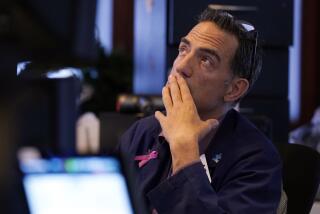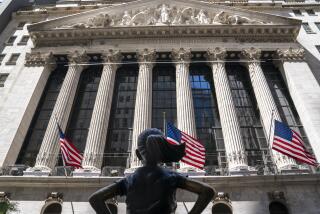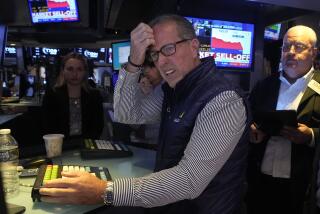Indian Stocks’ Volatility May Be Effect of Youth
- Share via
MUMBAI, India — Anyone tracking the Bombay Stock Exchange these days would be forgiven an attack of motion sickness.
The Sensex, India’s premier index, has swung wildly since May, climbing to vertiginous heights, dropping like a stone, then swooping up and down as investors attempt to catch their breath and regain some equilibrium.
Now, judging by their performance of the last few days, Indian stocks may be evening out, give or take a wobble or two. But the extreme volatility has left many here and abroad wondering what caused it and what to expect in one of the world’s hottest emerging markets.
By most accounts, the mushrooming Sensex was ripe for a correction. But no one anticipated such a huge wallop, which knocked the index from its record close of 12,612 points on May 10 down to 8,929 on June 14, its lowest point this year -- a loss of 29%. Trading was suspended for an hour at one point last month to help steel nerves; the tumble prompted a popular newsweekly to ask on its cover, “Is the India story over?”
Analysts credit the steep decline to a confluence of factors: global trends, government missteps and panic among Indian stockholders as they watched foreign investors unload shares from a young market still prone to what one commentator describes as flighty “teenage” behavior. But observers say conditions remain sound for steady growth in the world’s second-most-populous nation.
“The long-term India story is intact,” said Keshav Porwal, a vice president at SG Banking in Mumbai, part of France’s Societe Generale Group.
For a while, that story looked not just intact, but incredible. Buoyed by forecasts of 8% annual growth, low inflation, strong foreign-exchange reserves and rosy announcements from companies such as software giant Infosys Technologies Ltd., which said it would add 25,000 more jobs, the Sensex zoomed upward from the start of the year, sometimes adding nearly 100 points a session for days at a stretch. Giddy investors who had thought it would take until the end of 2006 to break 10,000 saw that barrier fall in February.
Some warned of a bubble. Sure enough, the first pinprick came May 10 -- the same day the Sensex closed at its all-time high -- when the U.S. Federal Reserve raised its benchmark short-term interest rate to 5%. The effects of the boost were felt not just in India but in emerging markets worldwide as foreign investors began to swap developing-country holdings for U.S. ones.
Then metal prices fell in London, which triggered a tumble in value for stocks in Indian powerhouses such as Tata Steel Ltd. and Hindalco Industries Ltd. (copper and aluminum). Rising oil prices also took their toll.
On top of these global trends was confusion on the home front resulting from a circular issued by India’s central tax board. Many interpreted it to mean that foreign institutional investors, or FIIs, which dictate much of the agenda in the Indian market, would lose preferential tax status. As anxiety over the news spread, India’s finance minister, Palaniappan Chidambaram, was forced to step in and deny that such a move was imminent.
But the cumulative damage was done. Foreign institutional investors started pulling up stakes, net-selling shares from May 16 through June 2 to the tune of nearly $2.5 billion.
Indian investors were spooked.
The 900 or so foreign institutional investors registered here “wield a disproportionate influence in the Indian market,” said Narayanan Madhavan, a senior editor at the Financial Express.
“India has its own institutional investors, but they are not big enough, strong enough, powerful enough,” Madhavan said. “When the FIIs cut down their purchases or shuffle their shares, or when they try to book profits, or when they try to reduce their exposure to the Indian market, these Indian speculators and investors tend to panic.”
Individual investors, many of whom had rushed into the market in leveraged positions to take advantage of the Sensex’s sensational rise, turned tail and beat a frantic path to the door.
Some say that such impulsive, often lemming-like behavior is to be expected from investors in a country where a free stock market is still a relatively novel development, in place for a mere 15 years.
“They lack the practice and experience to take foreign-investor behavior in their stride,” Madhavan said. “It’s more like teenage behavior sometimes.”
Foreign institutional investors remain a strong presence in the Indian market -- with $43.6 billion in investments as of May 31. This month, they have returned to buying, helping stocks rally somewhat in the last week or two. The Sensex closed Friday at 10,401.30, up 125.42 points.
Analysts say that the recent volatility on Dalal Street -- India’s Wall Street, located in Mumbai -- should not obscure the fact that overall conditions are in good shape to sustain India’s impressive economic growth of the last few years.
Inflation has largely been kept in check. The government has declared its commitment to improving the country’s inadequate infrastructure. Indian banking and corporate accounting practices are on a par with those of developed nations and its legal system is solid, if excruciatingly slow at times.
High-performing sectors such as information technology continue to grow at a galloping rate, with more modest gains in manufacturing. Market efficiencies are being introduced in agriculture as the middlemen who flourished under India’s formerly socialist economy get squeezed out. A huge population of young people should keep labor plentiful for decades.
And consumerism has taken firm root among those in the growing Indian middle class, who covet cars, home furnishings and clothes as well as entertainment and travel options.
“You can’t take your cues from the stock market momentum. The fundamentals are there,” said Jignesh Shah, chairman of Financial Technologies, a listed company that specializes in developing technology for use in financial transactions. “Unless played wrongly, 8% [annual gross domestic product growth] in the next five years seems to be a conservative” estimate.
Further corrections to some sectors are possible, such as real estate, which Porwal of SG Banking believes is overvalued. The increase in oil prices is also likely to continue to dent profits in other industries.
But most watchers of India’s economic revival remain bullish on its long-term prospects. The recent setback in the Sensex does not negate the fact that, since the government instituted its market reforms in 1991, the stock market has steadily multiplied in value, similar to that other remarkable Asian growth story: China.
“If somebody missed China in 1995, no one should say in 2015 that they missed India in 2006,” Shah said. “We shouldn’t miss the boat.”
More to Read
Inside the business of entertainment
The Wide Shot brings you news, analysis and insights on everything from streaming wars to production — and what it all means for the future.
You may occasionally receive promotional content from the Los Angeles Times.











